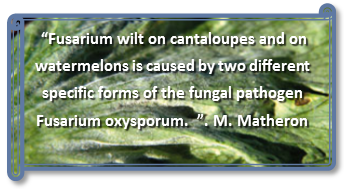One of the diseases that can occur in desert melon production fields is Fusarium
wilt. Symptoms of the disease on melons are similar to Fusarium wilt diseases on
other plants, usually beginning as an initial yellowing and wilting on one side
of the plant or on one runner, followed by runner collapse. Internal discoloration
of the xylem tissue at the base of the plant can be present as well. The xylem discoloration
is usually light yellow to tan in color, not the dark reddish brown observed on
lettuce. As the disease progresses, other runners will show symptoms and collapse,
eventually leading to plant death. Fusarium wilt on cantaloupes and on watermelons
is caused by two different specific forms of the fungal pathogen
Fusarium oxysporum.
For cantaloupes and other melons classified as Cucumis melo, the relevant pathogen
is Fusarium oxysporum f. sp. melonis; whereas the pathogen for watermelon (Citrullus
lanatus) is Fusarium oxysporum f. sp. niveum. In general, Fusarium wilt severity
increases when plants are stressed due to high temperature, heavy fruit loads, or
other plant growth stress factors. The use of resistant varieties is a useful disease
management tool; however, the performance of a resistant variety can be affected
by the inoculum level of the pathogen in soil. According to various published research
articles, rotation out of melons from three to 10 years can significantly reduce
but not eliminate the inoculum load of the pathogen in soil. There are numerous
different forms of the Fusarium wilt pathogen, and each form has the capability
of initiating disease on one or at most a few closely related types of plants. Are
you concerned about planting melons in a former lettuce field known to have had
Fusarium wilt? No worries. The Fusarium wilt pathogen of lettuce (
Fusarium oxysporum
f. sp.
lactucae) will not cause disease on melons.



